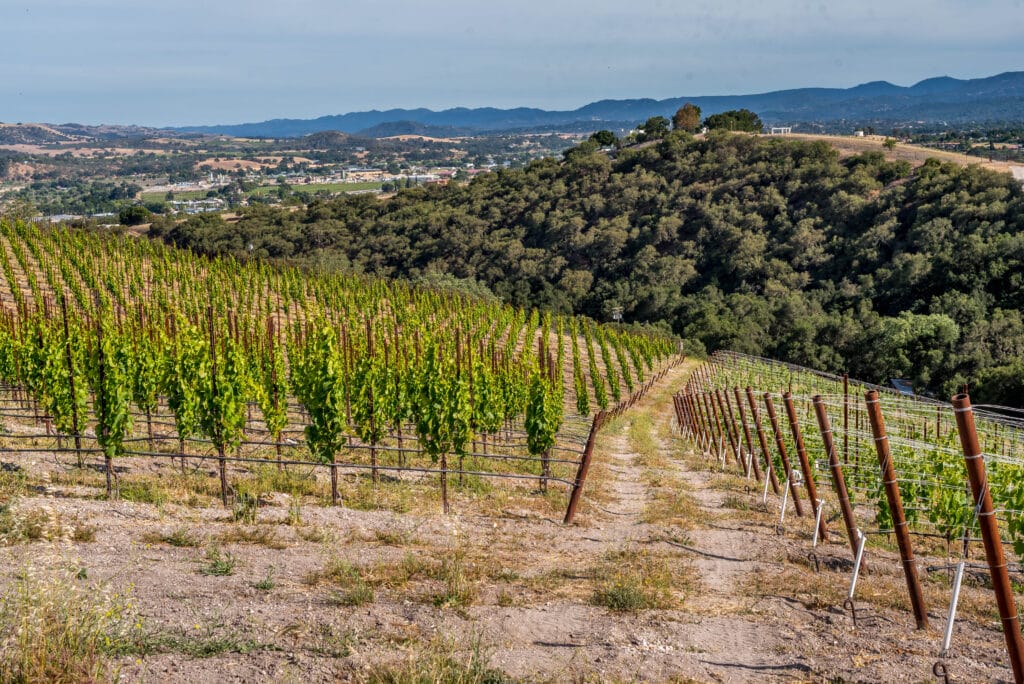A Visitor’s Guide to Paso Robles Wineries: Top Spots for Wine Tastings
There’s something unforgettable about the magic of Paso Robles wineries. Conversation flows easily, often about the vineyard, the vintage, or how the season shaped the wine in your glass. New flavors abound, and when you stumble into a tasting room, you never know when the winemaker might be the one pouring the wine.
Paso Robles has a welcoming, grounded energy. It doesn’t take itself too seriously. You can show up in jeans, strike up a real conversation, and leave feeling like you’ve made a connection.
Whether this is your first visit or your tenth, we put together our ultimate visitor’s guide to help you explore Paso like a local and find the kind of wine-tasting experiences that stick with you long after the last sip.
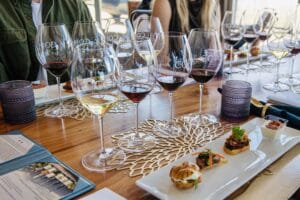
What Makes Paso Robles Wineries Special
Scale and Authentic Diversity
Paso Robles might surprise you with just how much vineyard land it holds – more than Napa and Sonoma combined. But what’s special is that, even with over 200 wineries spread out across 11 sub-regions, it still feels personal here.
Every corner of Paso has its voice. Some areas lean toward bold and structured wines, while others produce bright, elegant bottles that whisper of ocean breezes and limestone. No two spots are quite the same, and that’s part of the fun.
But what do we love most? The sense of community. Winemakers here aren’t in it to one-up each other. We share equipment, trade ideas, and cheer each other on. That rising-tide-lifts-all-boats mentality is real, and you can feel it when you visit.
Paso also leaves plenty of room to play. Unlike some older, more rigid wine regions, we’re not boxed in by tradition. You’ll find classic Bordeaux blends one moment and wild, creative field blends the next. This is a place where people take risks – and more often than not, those risks turn into something beautiful.
Shifting Terroir
One of the things we always tell first-time visitors is to notice how the wines change as you drive. Paso’s terrain is wildly diverse, and it shows in every glass.
Head toward the Templeton Gap and you’ll get wines with a cooler touch, more acidity, and more lift. Out in the eastern hills, the grapes soak up the blazing sun, giving you bold, powerful reds with plenty of richness.
With its higher elevation, the Adelaida District tends to bring a little more finesse and complexity. And the Willow Creek District, where limestone and calcareous soils create ideal conditions for Rhône varietals, gives you wines with exceptional mineral complexity and elegant structure that we find irresistible.
Each little pocket of land here tells its own story. That’s the magic of Paso – you’re never far from something different and new.
The Family-Owned Difference
Paso is still proudly family-run at its core. Most tasting rooms you’ll visit are owned by the folks who planted the vines, made the wine, and probably live just down the road.
That personal connection means you’re not just tasting what’s in the glass; you’re hearing the story behind it. You’ll meet people who light up when they talk about their winemaking choices, their vineyard’s quirks, or the lessons they’ve learned along the way. Sometimes, those stories include setbacks and heartbreak. But more often, they’re about resilience, joy, and love for the land.
That kind of realness is hard to fake – and it’s a big reason why people fall in love with Paso and keep coming back.
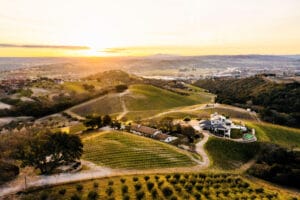
Planning Your Wine Country Adventure
Choosing Your Route Thoughtfully
If there’s one thing we’ve learned from watching friends explore Paso for the first time, it’s this: less really is more. Paso Robles covers a lot of ground, and trying to squeeze in too many tastings usually means you miss the best part: the people, the stories, and those unexpected moments that make a wine truly memorable.
If you’re just getting to know the area, Highway 46 West is a great place to start. It’s home to a wide mix of wineries, from well-established names to small-lot producers you might not have heard of yet. And they’re all just minutes from each other, which keeps things easy.
For a more focused experience, we recommend exploring the Adelaida and Willow Creek Districts, where we concentrate our efforts. These areas showcase some of Paso’s most distinctive terroir, with wineries that truly understand how to express their unique microclimates. The Adelaida District’s elevation brings complexity and finesse, while Willow Creek’s limestone-rich soils create wines with remarkable mineral depth.
Want something quieter and more personal? Head into Templeton. The wineries there tend to be smaller and family-run, and you’ll often find yourself chatting with someone who’s worked the land for years. The pace is slower, the crowds thinner, and the stories richer.
If you don’t mind a little extra drive time, the eastern hills reward you with gorgeous views and beautifully made wines. It feels like a little adventure – one that always ends with a glass in hand and a new favorite bottle to take home.
And while tasting maps and guides are helpful, don’t be afraid to go off-script. Some of our most unforgettable visits started with a handwritten sign on the side of the road and a hunch that we were heading somewhere good.
Smart Booking Strategy
Weekends in Paso – especially during spring festivals or around holidays like Memorial Day – fill up fast. If there’s a winery you’re excited to visit, book that first. Then let the rest of the day be shaped around it.
We recommend sticking to two to three tastings a day. This gives you time to truly enjoy each stop, ask questions, linger over your favorite pour, and squeeze in a vineyard walk or two. Tastings usually run from 11 AM to 4 PM, so you’ve got a nice window to work with.
If you’re planning a weekend visit, staying overnight is a game-changer. Our guest homes were created with wine lovers in mind; relaxed spaces where you can recharge, take in the views, and not worry about how far the next tasting room is.
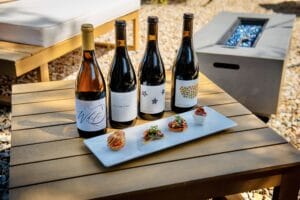
The Wines That Define Paso Robles
Rhône Varietals: Our Heart and Soul
Paso has built its reputation on Rhône varietals for good reason. Our climate is a perfect fit for grapes like Syrah, Grenache, and Mourvèdre. Warm, sunny days are balanced by cool nights that help the fruit ripen beautifully while keeping the wines fresh and balanced.
Syrah holds a special place in our hearts – Varinder always says it was his first real wine crush. When it’s grown in the right spot, Paso Robles Syrah can be deep and powerful, yet still graceful. Think black fruit, cracked pepper, and just the right touch of earthiness.
Grenache has won us over completely. It’s incredibly versatile and just plain joyful to drink. It’s also one of the best wines to pair with food, thanks to its brightness and energy.
And Mourvèdre? It brings a lovely structure and complexity to blends, but on its own, it can be rugged and soulful, with notes that remind us of dried herbs, game, and dusty trails on a summer day.
At Copia, our wine collection reflects this commitment to Rhône varietals. Each one tells the story of where it came from, from the soil and slope to the decisions made in the cellar. These are wines made with intention, and we think that shows in every glass.
Bordeaux Excellence at Accessible Prices
Paso’s also earned a following for its Bordeaux-style wines. Cabernet Sauvignon, Merlot, Petit Verdot – they all thrive in our region, thanks to the warm days and cool nights that preserve acidity and build rich flavor.
The best part? You don’t need to break the bank to find something exceptional here. Paso producers are focused on quality over flash. You’ll find handcrafted wines that deliver depth and elegance at a price that still leaves room for dinner.
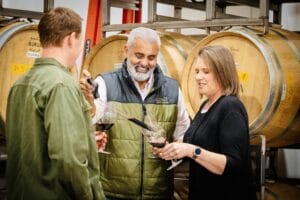
Making Every Tasting Count
What to Expect
Tasting fees usually fall between $20 and $35 per person. But here’s a little local insight: if you find something you love and decide to take home a few bottles, many wineries will waive your fee. Joining the wine club often adds even more value, with perks like exclusive events, early access to new releases, and complimentary tastings every time you come back.
Club members are often invited to things like winemaker dinners, harvest parties, and hands-on blending sessions. It’s a great way to stay connected, especially if Paso has become your happy place, like it has for us.
Connect With the People Behind the Wine
Your tasting experience is shaped as much by the people pouring your wine as by the wine itself. In Paso, tasting room teams are made up of folks who care about the wines, about hospitality, and about making sure you leave with something you’ll remember.
Don’t hesitate to share what kinds of wines you enjoy or ask questions about vineyard practices or winemaking choices. Honest conversations are always welcome, and they often lead to surprising recommendations. If something doesn’t hit your palate quite right, say so. The right pour is usually just around the corner.
Go Beyond the Standard Tasting
If you’re looking to make your visit extra special, ask about private tastings, vineyard tours, or food pairing experiences. These give you a deeper connection to the place and the people behind the wine.
Some wineries even offer a peek into the production process. Barrel tastings, harvest activities, and walking through the vineyard while sipping the wine grown right there; it all adds a little magic to your day.
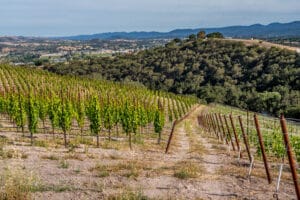
Practical Tips From Locals
Getting Around Without Stress
Paso’s back roads are beautiful, but they can be tricky to navigate, especially if you’re planning more than a couple of tastings. Hiring a local driver or joining a wine tour takes the pressure off. These folks know the area inside and out, and they’ll often take you to wineries you might not have found on your own.
If you’re using rideshare apps, double-check that your return ride is available, especially in the more remote spots. And if you’re driving yourself, take it slow and stay safe. Those winding country roads deserve your full attention.
Picking the Right Season to Visit
Every season brings something different to Paso:
- Spring is all about new growth and wildflowers, with the vineyards just starting to wake up. It’s a great time for a stroll through the vines and a picnic with a view.
- Summer gives you long, sunny days and lots of tasting opportunities. It can get warm, so morning or late afternoon visits are best.
- Fall is our favorite season. Harvest is in full swing, and you can feel the energy everywhere. Grapes are being picked, the air smells like fermentation, and winemakers barely sleep. It’s thrilling.
- Winter is quieter, more reflective. There are fewer crowds, more time to chat with winemakers, and a calm, cozy feel that we love.
Make Your Day Count
We always recommend two to three wineries per day – any more than that and the flavors (and memories) start to blur. Give yourself time to soak it all in.
A good schedule might look like this: start around 10 or 11 AM, take a break for lunch and your second tasting around 1 PM, and wrap up with a third around 3 or 4 PM. That leaves plenty of time for conversation and maybe even a glass or two on a patio somewhere with a view.
Take photos, jot down tasting notes, and don’t stress about buying at every stop. Many wineries offer shipping, so if you fall in love with something, you can always place an order from home once the moment settles.
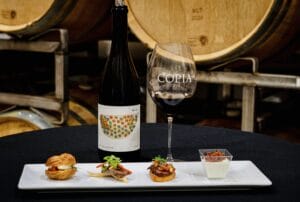
Your Invitation to Authentic Wine Country
What makes Paso truly special isn’t just the wine, though the wine is reason enough. It’s the sense of place, the feeling of being welcomed in, and the personal stories poured into every bottle.
Whether you’re just starting your wine journey or have been collecting for years, you’ll find people here who are excited to share, connect, and celebrate right alongside you.
We’d love to be part of your Paso experience. When you’re ready to visit, we hope Copia Vineyards makes your list.
Warmly,
Anita and Varinder Sahi


